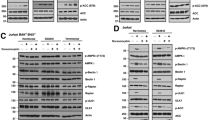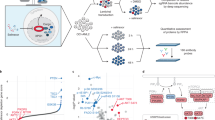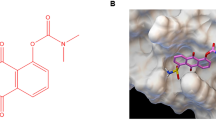Abstract
We have reported previously that R-enantiomer of etodolac (R-etodolac), which is under investigation in phase 2 clinical trials in chronic lymphocytic leukemia, induces potent cytotoxicity at clinically relevant concentrations in multiple myeloma (MM) cells. In this study, we demonstrated that SDX-308 (CEP-18082), a novel analog of etodolac, has more potent cytotoxicity than R-etodolac against both MM cell lines and patient MM cells, including tumor cells resistant to conventional (dexamethasone, doxorubicine, melphalan) and novel (bortezomib) therapies. SDX-308-induced cytotoxicity is triggered by caspase-8/9/3 activation and poly (ADP-ribose) polymerase cleavage, followed by apoptosis. SDX-308 significantly inhibits β-catenin/T-cell factor pathway by inhibiting nuclear translocation of β-catenin, thereby downregulating transcription and expression of downstream target proteins including myc and survivin. Neither interleukin-6 nor insulin-like growth factor-1 protect against growth inhibition triggered by SDX-308. Importantly, growth of MM cells adherent to bone marrow (BM) stromal cells is also significantly inhibited by SDX-308. Our data therefore indicate that the novel etodolac analog SDX-308 can target MM cells in the BM milieu.
This is a preview of subscription content, access via your institution
Access options
Subscribe to this journal
Receive 12 print issues and online access
$259.00 per year
only $21.58 per issue
Buy this article
- Purchase on Springer Link
- Instant access to full article PDF
Prices may be subject to local taxes which are calculated during checkout





Similar content being viewed by others
References
Humber LG, Demerson CA, Swaminathan P, Bird PH . Etodolac (1,8-diethyl-1,3,4,9-tetrahydropyrano[3,4-b]indole-1-acetic acid): a potent antiinflammatory drug. Conformation and absolute configuration of its active enantiomer. J Med Chem 1986; 29: 871–874.
Ulrich CM, Bigler J, Potter JD . Non-steroidal anti-inflammatory drugs for cancer prevention: promise, perils and pharmacogenetics. Nat Rev Cancer 2006; 6: 130–140.
Yasui H, Hideshima T, Hamasaki M, Roccaro AM, Shiraishi N, Kumar S et al. SDX-101, the R-enantiomer of etodolac, induces cytotoxicity, overcomes drug resistance, and enhances the activity of dexamethasone in multiple myeloma. Blood 2005; 106: 706–712.
Lu D, Cottam HB, Corr M, Carson DA . Repression of β-catenin function in malignant cells by nonsteroidal antiinflammatory drugs. Proc Natl Acad Sci USA 2005; 102: 18567–18571.
Boon EM, Keller JJ, Wormhoudt TA, Giardiello FM, Offerhaus GJ, van der Neut R et al. Sulindac targets nuclear β-catenin accumulation and Wnt signalling in adenomas of patients with familial adenomatous polyposis and in human colorectal cancer cell lines. Br J Cancer 2004; 90: 224–229.
Lu D, Zhao Y, Tawatao R, Cottam HB, Sen M, Leoni LM et al. Activation of the Wnt signaling pathway in chronic lymphocytic leukemia. Proc Natl Acad Sci USA 2004; 101: 3118–3123.
Grosch S, Maier TJ, Schiffmann S, Geisslinger G . Cyclooxygenase-2 (COX-2)-independent anticarcinogenic effects of selective COX-2 inhibitors. J Natl Cancer Inst 2006; 98: 736–747.
Moon RT, Kohn AD, De Ferrari GV, Kaykas A . WNT and β-catenin signaling: diseases and therapies. Nat Rev Genet 2004; 5: 691–701.
Reya T, Clevers H . Wnt signalling in stem cells and cancer. Nature 2005; 434: 843–850.
Langenau DM, Traver D, Ferrando AA, Kutok JL, Aster JC, Kanki JP et al. Myc-induced T cell leukemia in transgenic zebrafish. Science 2003; 299: 887–890.
He TC, Sparks AB, Rago C, Hermeking H, Zawel L, da Costa LT et al. Identification of c-MYC as a target of the APC pathway. Science 1998; 281: 1509–1512.
Ma H, Nguyen C, Lee KS, Kahn M . Differential roles for the coactivators CBP and p300 on TCF/β-catenin-mediated survivin gene expression. Oncogene 2005; 24: 3619–3631.
Zhang T, Otevrel T, Gao Z, Gao Z, Ehrlich SM, Fields JZ et al. Evidence that APC regulates survivin expression: a possible mechanism contributing to the stem cell origin of colon cancer. Cancer Res 2001; 61: 8664–8667.
Tetsu O, McCormick F . β-catenin regulates expression of cyclin D1 in colon carcinoma cells. Nature 1999; 398: 422–426.
Morin PJ, Sparks AB, Korinek V, Barker N, Clevers H, Vogelstein B et al. Activation of beta-catenin–TCF signaling in colon cancer by mutations in beta-catenin or APC. Science 1997; 275: 1787–1790.
Derksen PW, Tjin E, Meijer HP, Klok MD, MacGillavry HD, van Oers MH et al. Illegitimate WNT signaling promotes proliferation of multiple myeloma cells. Proc Natl Acad Sci USA 2004; 101: 6122–6127.
Yasui H, Hideshima T, Richardson PG, Anderson KC . Novel therapeutic strategies targeting growth factor signaling cascades in multiple myeloma. Br J Haematol 2006; 132: 385–397.
Yasui H, Hideshima T, Raje N, Roccaro AM, Shiraishi N, Kumar S et al. FTY720 induces apoptosis in multiple myeloma cells and overcomes drug resistance. Cancer Res 2005; 65: 7478–7484.
Kawano M, Hirano T, Matsuda T, Taga T, Horii Y, Iwato K et al. Autocrine generation and requirement of BSF-2/IL-6 for human multiple myelomas. Nature 1988; 332: 83–85.
Chauhan D, Kharbanda S, Ogata A, Urashima M, Teoh G, Robertson M et al. Interleukin-6 inhibits Fas-induced apoptosis and stress-activated protein kinase activation in multiple myeloma cells. Blood 1997; 89: 227–234.
Ogawa M, Nishiura T, Oritani K, Yoshida H, Yoshimura M, Okajima Y et al. Cytokines prevent dexamethasone-induced apoptosis via the activation of mitogen-activated protein kinase and phosphatidylinositol 3-kinase pathways in a new multiple myeloma cell line. Cancer Res 2000; 60: 4262–4269.
Mitsiades CS, Mitsiades NS, McMullan CJ, Poulaki V, Shringarpure R, Akiyama M et al. Inhibition of the insulin-like growth factor receptor-1 tyrosine kinase activity as a therapeutic strategy for multiple myeloma, other hematologic malignancies, and solid tumors. Cancer Cell 2004; 5: 221–230.
Uchiyama H, Barut BA, Mohrbacher AF, Chauhan D, Anderson KC . Adhesion of human myeloma-derived cell lines to bone marrow stromal cells stimulates interleukin-6 secretion. Blood 1993; 82: 3712–3720.
Hideshima T, Chauhan D, Schlossman R, Richardson P, Anderson KC . The role of tumor necrosis factor α in the pathophysiology of human multiple myeloma: therapeutic applications. Oncogene 2001; 20: 4519–4527.
Hideshima T, Chauhan D, Richardson P, Mitsiades C, Mitsiades N, Hayashi T et al. NF-κB as a therapeutic target in multiple myeloma. J Biol Chem 2002; 277: 16639–16647.
Hideshima T, Anderson KC . Molecular mechanisms of novel therapeutic approaches for multiple myeloma. Nat Rev Cancer 2002; 2: 927–937.
Kyle RA, Rajkumar SV . Multiple myeloma. N Engl J Med 2004; 351: 1860–1873.
Yasui H, Hideshima T, Richardson PG, Anderson KC . Recent advances in the treatment of multiple myeloma. Curr Pharma Biotechnol 2006; 7: 381–393.
Singhal S, Mehta J, Desikan R, Ayers D, Roberson P, Eddlemon P et al. Antitumor activity of thalidomide in refractory multiple myeloma. N Engl J Med 1999; 341: 1565–1571.
Hideshima T, Chauhan D, Shima Y, Raje N, Davies FE, Tai YT et al. Thalidomide and its analogs overcome drug resistance of human multiple myeloma cells to conventional therapy. Blood 2000; 96: 2943–2950.
Rajkumar SV, Hayman SR, Lacy MQ, Dispenzieri A, Geyer SM, Kabat B et al. Combination therapy with lenalidomide plus dexamethasone (Rev/Dex) for newly diagnosed myeloma. Blood 2005; 106: 4050–4053.
Richardson PG, Blood E, Mitsiades CS, Jagannath S, Zeldenrust S, Alsina M et al. A randomized phase 2 study of lenalidomide therapy for patients with relapsed or relapsed and refractory multiple myeloma. Blood 2006; 108: 3458–3464.
Hideshima T, Richardson P, Chauhan D, Palombella VJ, Elliott PJ, Adams J et al. The proteasome inhibitor PS-341 inhibits growth, induces apoptosis, and overcomes drug resistance in human multiple myeloma cells. Cancer Res 2001; 61: 3071–3076.
Richardson PG, Sonneveld P, Schuster MW, Irwin D, Stadtmauer EA, Facon T et al. Bortezomib or high-dose dexamethasone for relapsed multiple myeloma. N Engl J Med 2005; 352: 2487–2498.
Hideshima T, Bergsagel PL, Kuehl WM, Anderson KC . Advances in biology of multiple myeloma: clinical applications. Blood 2004; 104: 607–618.
Zhang L, Yu J, Park BH, Kinzler KW, Vogelstein B . Role of BAX in the apoptotic response to anticancer agents. Science 2000; 290: 989–992.
Huls G, Koornstra JJ, Kleibeuker JH . Non-steroidal anti-inflammatory drugs and molecular carcinogenesis of colorectal carcinomas. Lancet 2003; 362: 230–232.
Corley DA, Kerlikowske K, Verma R, Buffler P . Protective association of aspirin/NSAIDs and esophageal cancer: a systematic review and meta-analysis. Gastroenterology 2003; 124: 47–56.
Wang WH, Huang JQ, Zheng GF, Lam SK, Karlberg J, Wong BC . Non-steroidal anti-inflammatory drug use and the risk of gastric cancer: a systematic review and meta-analysis. J Natl Cancer Inst 2003; 95: 1784–1791.
Terry MB, Gammon MD, Zhang FF, Tawfik H, Teitelbaum SL, Britton JA et al. Association of frequency and duration of aspirin use and hormone receptor status with breast cancer risk. JAMA 2004; 291: 2433–2440.
Tegeder I, Pfeilschifter J, Geisslinger G . Cyclooxygenase-independent actions of cyclooxygenase inhibitors. FASEB J 2001; 15: 2057–2072.
Yin MJ, Yamamoto Y, Gaynor RB . The anti-inflammatory agents aspirin and salicylate inhibit the activity of I(kappa)B kinase-beta. Nature 1998; 396: 77–80.
Yasui H, Adachi M, Imai K . Combination of tumor necrosis factor-α with sulindac augments its apoptotic potential and suppresses tumor growth of human carcinoma cells in nude mice. Cancer 2003; 97: 1412–1420.
Karin M, Yamamoto Y, Wang QM . The IKK NF-κB system: a treasure trove for drug development. Nat Rev Drug Discov 2004; 3: 17–26.
Rice PL, Goldberg RJ, Ray EC, Driggers LJ, Ahnen DJ . Inhibition of extracellular signal-regulated kinase 1/2 phosphorylation and induction of apoptosis by sulindac metabolites. Cancer Res 2001; 61: 1541–1547.
Kulp SK, Yang YT, Hung CC, Chen KF, Lai JP, Tseng PH et al. 3-phosphoinositide-dependent protein kinase-1/Akt signaling represents a major cyclooxygenase-2-independent target for celecoxib in prostate cancer cells. Cancer Res 2004; 64: 1444–1451.
Kardosh A, Soriano N, Liu YT, Uddin J, Petasis NA, Hofman FM et al. Multitarget inhibition of drug-resistant multiple myeloma cell lines by dimethyl-celecoxib (DMC), a non-COX-2 inhibitory analog of celecoxib. Blood 2005; 106: 4330–4338.
Hedvat M, Jain A, Carson DA, Leoni LM, Huang G, Holden S et al. Inhibition of HER-kinase activation prevents ERK-mediated degradation of PPARgamma. Cancer Cell 2004; 5: 565–574.
Kolluri SK, Corr M, James SY, Bernasconi M, Lu D, Liu W et al. The R-enantiomer of the nonsteroidal antiinflammatory drug etodolac binds retinoid X receptor and induces tumor-selective apoptosis. Proc Natl Acad Sci USA 2005; 102: 2525–2530.
Neri P, Yasui H, Hideshima T, Tassone P, Raje N, Catley LP et al. In vivo and in vitro cytotoxicity of R-etodolac with dexamethasone in glucocorticoid-resistant multiple myeloma cells. Br J Haematol 2006; 134: 37–44.
Voeller HJ, Truica CI, Gelmann EP . β-catenin mutations in human prostate cancer. Cancer Res 1998; 58: 2520–2523.
Lin SY, Xia W, Wang JC, Kwong KY, Spohn B, Wen Y et al. β-catenin, a novel prognostic marker for breast cancer: its roles in cyclin D1 expression and cancer progression. Proc Natl Acad Sci USA 2000; 97: 4262–4266.
Shringarpure R, Catley L, Bhole D, Burger R, Podar K, Tai YT et al. Gene expression analysis of B-lymphoma cells resistant and sensitive to bortezomib. Br J Haematol 2006; 134: 145–156.
Ogata A, Chauhan D, Teoh G, Treon SP, Urashima M, Schlossman RL et al. IL-6 triggers cell growth via the Ras-dependent mitogen-activated protein kinase cascade. J Immunol 1997; 159: 2212–2221.
Hideshima T, Nakamura N, Chauhan D, Anderson KC . Biologic sequelae of interleukin-6 induced PI3-K/Akt signaling in multiple myeloma. Oncogene 2001; 20: 5991–6000.
Catlett-Falcone R, Landowski TH, Oshiro MM, Turkson J, Levitzki A, Savino R et al. Constitutive activation of Stat3 signaling confers resistance to apoptosis in human U266 myeloma cells. Immunity 1999; 10: 105–115.
Acknowledgements
This study is supported by National Institutes of Health (NIH) SPORE IP50 CA10070, PO-1 78378 and RO-1 CA 50947 Grants; the Doris Duke Distinguished Clinical Research Scientist Award (KCA); the Multiple Myeloma Research Foundation (TH); and the Lebow Family Fund to Cure Myeloma (KCA). SDX-308 (CEP-18082) is provided by Salmedix Inc. now doing business as Cephalon, Inc.
Author information
Authors and Affiliations
Corresponding author
Additional information
Supplementary Information accompanies the paper on the Leukemia website (http://www.nature.com/leu)
Supplementary information
Rights and permissions
About this article
Cite this article
Yasui, H., Hideshima, T., Ikeda, H. et al. Novel etodolac analog SDX-308 (CEP-18082) induces cytotoxicity in multiple myeloma cells associated with inhibition of β-catenin/TCF pathway. Leukemia 21, 535–540 (2007). https://doi.org/10.1038/sj.leu.2404561
Received:
Revised:
Accepted:
Published:
Issue Date:
DOI: https://doi.org/10.1038/sj.leu.2404561
Keywords
This article is cited by
-
The EMT activator ZEB1 promotes tumor growth and determines differential response to chemotherapy in mantle cell lymphoma
Cell Death & Differentiation (2014)
-
AV-65, a novel Wnt/β-catenin signal inhibitor, successfully suppresses progression of multiple myeloma in a mouse model
Blood Cancer Journal (2011)



